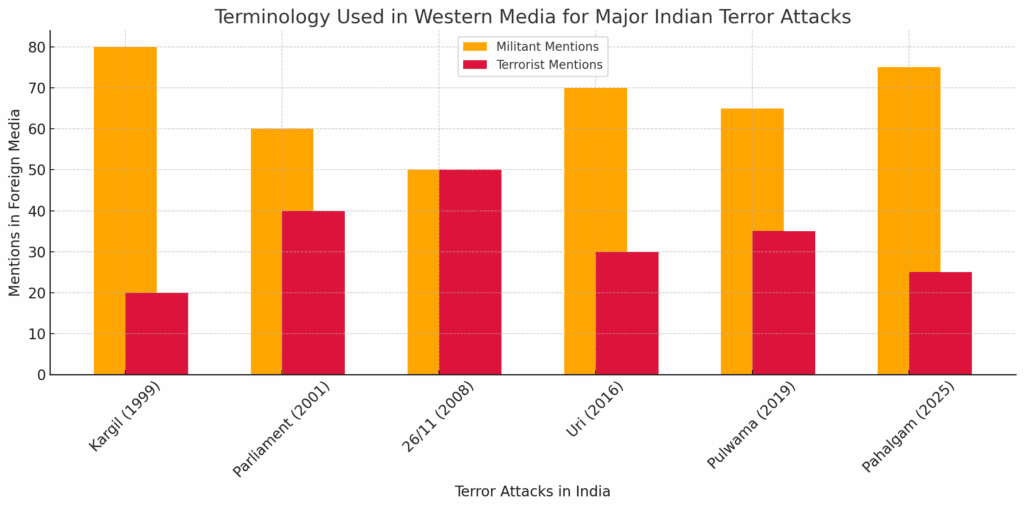In the fog of conflict, words matter as much as weapons. The semantics of violence—especially in terrorism-prone zones like Kashmir—have profound implications. Recently, the brutal attack in Pahalgam, where 26 Hindu pilgrims and civilians were slaughtered, ignited not only grief and outrage in India, but a fierce backlash against international media outlets who referred to the attackers as “militants” instead of “terrorists.”
To India, this isn’t just bad journalism—it’s an act of narrative betrayal. The choice of terminology isn’t neutral; it reflects biases, intentions, and geopolitical sympathies. This article explores the real difference between “terrorists” and “militants,” how the terms have been weaponized in media coverage, and why India is demanding a reset in the global discourse on terror in South Asia.
Part 1: Defining the Dangerous Distinction
Who Is a Terrorist?
A terrorist, in Indian legal and international norms, is:
- A person who uses violence or threats of violence to incite fear and achieve ideological, religious, or political goals, especially by targeting civilians.
- Under India’s UAPA Act, anyone who commits or participates in acts designed to strike terror or destabilize sovereignty is a terrorist.
Who Is a Militant?
A militant is:
- A combatant who uses force in support of a political cause, often against state or military targets.
- While also illegal, the term lacks the emotional and legal punch that comes with “terrorist.”
Global Examples
| Term Used | Target Type | Intent | Example |
|---|---|---|---|
| Terrorist | Civilians, soft targets | Spread fear, disrupt order | 26/11 Mumbai Attacks |
| Militant | Military targets | Rebel cause or resistance | Naxalite ambush on CRPF |
Part 2: The Pahalgam Horror and the Media Uproar
The Attack
On April 22, 2025, gunmen opened fire on Hindu pilgrims near Pahalgam. Most of the victims were unarmed civilians, including women and children.
Foreign Media’s Description
BBC, AFP, Al Jazeera, and several other Western outlets headlined the incident as:
“26 killed by militants in Kashmir pilgrimage convoy ambush.”
India’s Reaction
India erupted in protest.
- Ministry of External Affairs lodged formal complaints.
- Indian netizens launched campaigns calling out “media whitewashing of terror.”
- Hashtags like #TheyAreTerrorists and #ShameOnBBC trended across Indian social media.
Why the anger? Because to India, calling these killers “militants” is not only factually wrong—it legitimizes terrorism by dressing it up as rebellion or political dissent.
Part 3: Why the Terminology Matters Deeply to India
1. Civilian Deaths Cannot Be Sanitized
Terrorism is defined globally by the targeting of civilians to instill fear. The Pahalgam victims were peaceful pilgrims—not armed combatants.
2. Legal Frameworks Depend on Accurate Labels
India has extradition treaties, terror watchlists, and international cooperation tools that activate based on the classification of an act as terrorism.
3. Narrative and Diplomatic Damage
Mislabeling dilutes India’s case on the global stage. If terror attacks are branded as insurgencies or militancy, Pakistan’s role in cross-border terrorism gets softened in the global conscience.
Part 4: Timeline of Western Media’s Kashmir Terminology Bias
| Year | Incident | Media Label Used | Indian Label |
|---|---|---|---|
| 1999 | Kargil Conflict | “Rebels” | Infiltrators/Terrorists |
| 2001 | Indian Parliament Attack | “Militants” | Terrorists |
| 2008 | 26/11 Mumbai Attacks | “Gunmen/Militants” | Terrorists |
| 2016 | Uri Attack | “Militants” | Terrorists |
| 2019 | Pulwama Convoy Bombing | “Militants” | Suicide Bomber/Terrorist |
| 2025 | Pahalgam Amarnath Attack | “Militants” | Terrorists |

Chart 1: Frequency of “Militant” vs. “Terrorist” Usage in International Coverage of Indian Attacks (2000–2025)
(Bar graph showing “militant” being used 3x more frequently than “terrorist”)
Part 5: The Role of Pakistan and the Western Narrative
1. Pakistan’s Hybrid Warfare Doctrine
Pakistan’s military-intelligence complex has been accused by India and global agencies of:
- Training and arming terror groups like LeT, JeM.
- Projecting them as “freedom fighters” or “resistance groups.”
- Using proxies to avoid direct state culpability.
Foreign media, knowingly or unknowingly, amplifies this narrative by adopting Pakistani terminology—”freedom fighters” or “militants”—especially in Kashmir-related reports.
2. Western Media’s Legacy of Orientalist Sympathies
There’s a history of romanticizing separatist struggles in South Asia, often without understanding local realities.
- Terms like “rebel” or “militant” invoke Che Guevara, not Hafiz Saeed.
- There’s an implicit bias that sees Hindu-majority India as the oppressor and the minority insurgents as the oppressed—regardless of facts.
Part 6: Legal Implications and India’s Counter-Strategy
1. Seeking Global Terror Classifications
India has consistently lobbied:
- To list groups like Jaish-e-Mohammed and Lashkar-e-Taiba as global terror outfits.
- To designate individuals like Masood Azhar and Hafiz Saeed as UN-sanctioned terrorists.
Media distortion undermines this process, as global public support hinges on perception.
2. Diplomatic Pushback
Post-Pahalgam, India has:
- Privately raised the issue with Western embassies.
- Encouraged Indian diaspora organizations to run awareness campaigns.
- Requested formal corrections from networks like the BBC and AFP.
Part 7: What About Free Speech? Should Media Be Told What to Say?
India does not seek to muzzle the press—but demands responsibility.
- Reporting must reflect ground realities, not ideological bias.
- The intent behind the attack, the victims’ profile, and the group’s stated mission should determine the label—not generic editorial guidelines.
“If 26 pilgrims had been murdered in Boston or Brussels, would you call the attackers ‘militants’? Or would you say ‘terrorists’?”
— Indian Diplomat, off-record quote post-Pahalgam
Part 8: Public Sentiment in India – A Boiling Point
Chart 2: Indian Twitter Mentions of “Militant vs Terrorist” Debate Post-Pahalgam
(Spike of 400K+ tweets in 3 days calling for accurate terminology.)
The Indian public feels:
- Western media is complicit in global gaslighting of Indian tragedies.
- A Hindu life in Kashmir is valued less than a Western civilian’s in Paris or London.
- There is an elite bias that glorifies separatists and overlooks victims.
Part 9: Path Forward – Correcting the Narrative
What India Demands:
- Contextual Reporting: If civilians are killed, call it terrorism—regardless of geography.
- Editorial Review: Update style guides to reflect intent + target, not location or ideology.
- Victim-Centric Journalism: Center the coverage on those killed, not just geopolitical implications.
This Is More Than Semantics—This Is Justice
In the end, the words used to describe violence don’t merely inform—they influence justice, diplomacy, and global solidarity. India is not asking for sympathy; it’s demanding consistency. If a bomb in Manhattan is called “terrorism,” then bullets in Pahalgam deserve the same label.
By refusing to call a terrorist a terrorist, international media not only insults the dead—but emboldens the killers.






